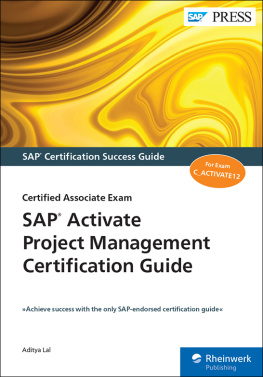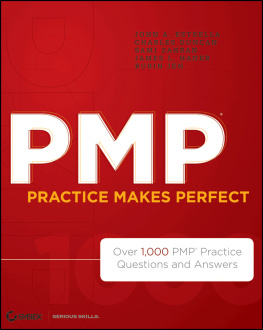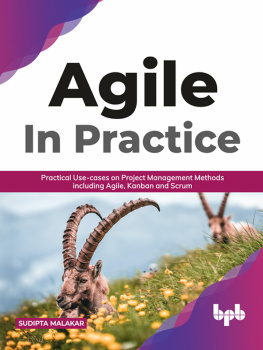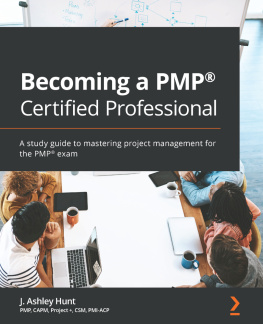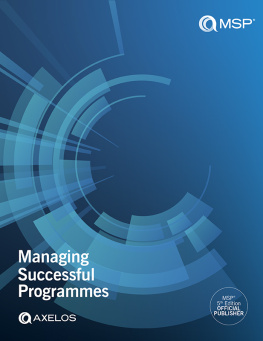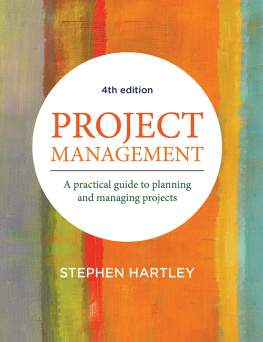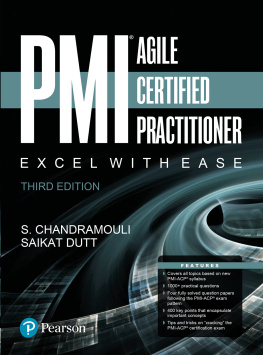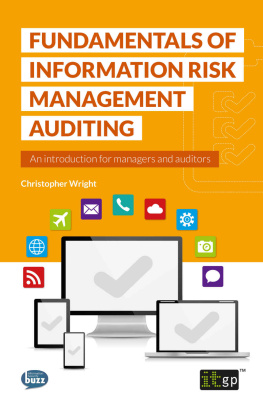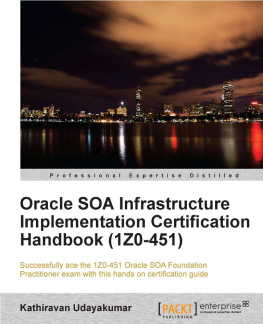Prince2 2017 Certification Foundation and Practitioner Guidebook
Sarah Taylor
Disclaimer
This information is provided and sold with the knowledge that the publisher and author do not offer any legal or other professional advice. In the case of a need for any such expertise consult with the appropriate professional. This book does not contain all information available on the subject. This book has not been created to be specific to any individuals or organizations situation or needs. Every effort has been made to make this book as accurate as possible. However, there may be typographical and or content errors. Therefore, this book should serve only as a general guide and not as the ultimate source of subject information. This book contains information that might be dated and is intended only to educate and entertain. The author and publisher shall have no liability or responsibility to any person or entity regarding any loss or damage incurred, or alleged to have incurred, directly or indirectly, by the information contained in this book. You hereby agree to be bound by this disclaimer or you may return this book within the guarantee time period for a full refund.
Contents
P RINCE2, or project in a controlled environment, is a process-based and very practical approach to project management. Assembled by the UK government by gathering years of best practices for both government organizations and companies in the private sector. These years of gathering best practices made for an easy to use, easy to implement management method that could be applied to any project no matter what size, complexity, or industry. This book will give you an introduction to PRINCE2. But we will explain the added value of PRINCE2 to the organization, but also what the added value of PRINCE2 is on an individual level. The intended audience for this book are all people involved in a project. Because although you might not have a management position in the project, it is still very valuable to have an understanding of the topics, organization, and responsibilities in a project. So let's take a look at what you'll be learning in this book. The first module, being this one, explains to you what the PRINCE2 method is, what are projects and why do we even need a project management method? And why should I use PRINCE2 as that method? Then in the next module, we will go into the details of the PRINCE2 certification. What levels of certification does PRINCE2 have and what are the best ways of getting certified. Then in the last four modules we will provide an overview of the PRINCE2 concepts, principles, which are the key success factors for your project, the principal organization, and its roles and responsibilities, the PRINCE2 processes that give you a sense of what activities need to be carried out, and finally, in the last module of this book we will give an overview of the different PRINCE2 knowledge areas named the PRINCE2 themes. Now let's take a look at what exactly we'll be learning in the first module. Like we said, this will be an introduction to PRINCE2, but before we get down to the method itself, we'll first discuss some basics and what a project is, what a project management method is, and why it is important for you and your organization to use a project management method. Then we'll look at the PRINCE2, its history, characteristics, and what problems are countered using the PRINCE2 project management method. Then finally, we'll look at other project management methods out there to see what makes PRINCE2 different and how it can work together with these other methods. All of it to give you the best combination of tools and knowledge for project management.
A lright in order to introduce the PRINCE2 project management method, it is important to first explain what projects are and why the world is so desperately in need of a good project management method. To start off with the first question, what are projects? Let us look at the basics of an organization. An organization, and this can be anything from a nonprofit organization to a government organization or a commercial company, always have stakeholders that influence the organization. These can be external where your organization has little control over them, like legislation, the way the market is developing, suppliers, and the way the local community views the organization. There are also internal factors, like employees or management who will have to make important decisions about the organization. Now this is just a small list, but normally the list of stakeholders in an organization is all but endless. Now this might look like a pretty static picture, but in reality these factors are constantly changing and it's up to the organization to adapt to these changes if it wants to remain successful. It is basically a constant juggling to keep the organization adapt to these changes, and that's where projects come in. Projects are a vehicle to help the organization implement changes. These changes help the organization to stay adaptive and to leverage both the internal and the external influence to the organization. So what makes up a project then? Well like we said, first it's a vehicle to implement change into the organization, and these days change is almost constant, that's why you'll find that most organizations have numerous projects running at the same time, just to keep with the ever increasing pace of changes that impact your organization. Second, is the projects are unique, they only happen once. Projects implement change, so inherently they are only done once because changes can't be implemented twice in the same manner. Everything that is repeated in an organization is considered routine operations or daily business, if you will. A simplified example here would be the old car industry. Here the daily business is producing cars using an assembly line. This is the routine, or daily business, because it produces numerous cars a day. Now a project in this example would be making changes to the assembly line to create a new set of cars. This particular change in the assembly line is unique and only happens once and can therefore be considered the project. When the assembly line is being used again to produce cars, this is once again part of the daily business. And finally, projects are temporary. They are formed for the sole purpose of implementing the change to your organization and usually consistent of people with different expertise from different departments or even different companies. Once the changes have been completed, the project is finished and it ceases to exist. Then all the people in the project go on their way and attend other duties. Okay, so now we know how a project is defined. So why do I need a project management method? Well that's because there's an ugly truth to projects in general, and especially an IT project, and that is unfortunately that projects tend to fail. Somehow it is extremely hard to get a project to be delivered on time, on budget, while delivering the quality that is expected. Let's look at some numbers I got from the McKenzie and Company in conjunction with University of Oxford and KPMG New Zealand. 45% of the IT projects go over budget, so almost half to the IT project eventually costs more than originally anticipated. Then 7% of the projects are over time. This in itself is not really staggering, but combined with these other numbers, they do add up to the number of projects that were unsuccessful. Then a staggering 56% of IT projects do not meet the quality standards that were expected by the customer. Then another one, only 40% of the projects actually meet the project goals that means that 60% of the projects do not meet their goals. And lastly, it turns out that so called runaway projects, projects that really break the fail records, make up for 70% of the projects and these projects actually threaten company existence. So yeah, you can see why the need for a good project management method came to be. Or perhaps this quote from Karen Tate, a well-respected expert in the field of project management, and part of the project management institute, explains better. "Trying to manage a project without project management is like trying to play a football game without a game plan." In other words, if you are trying to run a project without project management, you are going to lose. Alright so we have established that project management is crucial. But then why would you go ahead and select PRINCE2 as a project management method?
Next page




